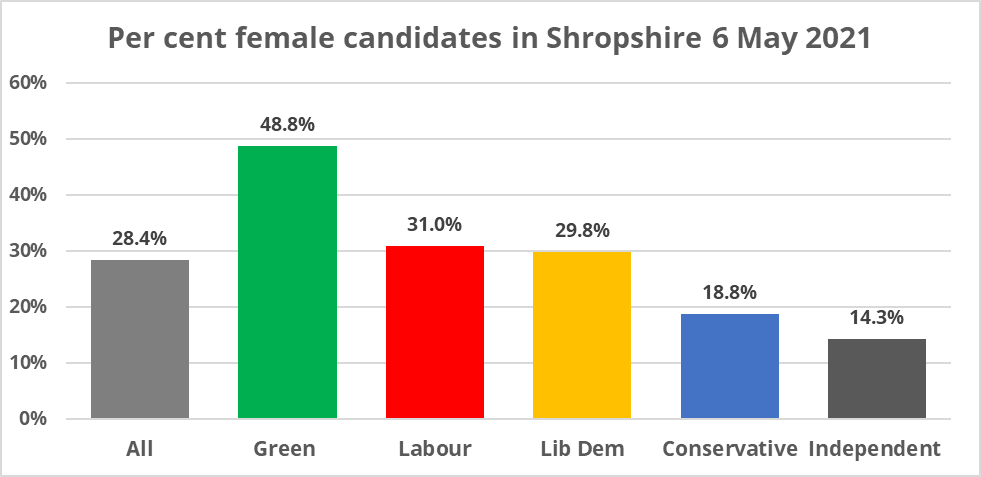With thanks to the Fawcett Society and the Democracy Club, we can analyse the gender of the more than 21,000 candidates that stood in elections on 6 May. Just one third were women (33%). Of the major parties, the Greens had the highest proportion of women at 43%, followed by Labour (41%), the Lib Dems (31%) and the Conservatives (27%).
I was one of 232 candidates standing for Shropshire Council on 6 May. It was depressingly like the national picture. Only 28.4% of candidates were women: Green 48.8%; Labour 31%; Lib Dems 29.8%; Conservatives 18.8%; and Independents just 14.3%. The newly elected council is now just 24.3% female.
Why? I think if we really understood why, we would have as many women pitching for election as men.
I don’t think councils can represent their communities well if they do not look like communities. Shropshire is not ethnically diverse. Just two per cent of residents are non-white and we have no unitary councillors from ethnic backgrounds. But just over half of our population is female. I instinctively feel that we should be reflecting that in our body of councillors.
This article sets out the data and asks why relative few women are standing for elections. It does not provide any answers.
Long ago, in the dark ages of democracy, it was almost all men. I remember attending the infamous smoke filled rooms of men puffing on their pipes and puffing out their opinion on how their town or county should be run.
Thank goodness that has ended. No smoking and an expectation that women have an equal right to participate are the new normal. Of course, puffing out opinion, no matter how ill informed, remains a core value of politics. Meetings are in theory gender neutral but why, oh why, are so few women standing for local councils and other public roles today?
The lack of gender balance is not restricted to a few areas. In Scotland, 37.5% of candidates on 6 May were women. In the Welsh Senedd elections, just 196 of the 634 candidates were women (30.9%). The London mayoral election has greater gender equality at 41% female candidates.
Looking at the 46 English counties and districts where 50 or more seats were up for grabs, there were higher proportions of women in Doncaster (41.9%), Chorley (41.0%) and Cambridge (40.7%). Coming in at the bottom were Gloucestershire (27.9%), Leeds (26.6%) and Isle of Wight (24.6%).
As I said at the top of this article, it can’t just be about selection as only 23.6% of independent candidates were women (I have excluded the various independent parties from this calculation as they presumably have some form of selection).
In a report published in 2018, Sue Maguire from the University of Bath summarised some of the barriers to women participating:
“The white, middle class and male dominated environment of British politics (both national and local government) is a major barrier to widening participation among women and other under-represented groups. Women’s continued role in assuming caring and household responsibilities poses another significant barrier, especially among younger women and those with young children.”
She adds that lack of financial resources may also be contributing along with weaker motivational factors such as ambition, self-confidence, self-belief and dedication.
We need to create a political environment that encourages women and ways of working that encourage women. Equal participation might lead to different priorities for councils. I am sure that could only be a good thing.
A version of this article was published on Lib Dem Voice yesterday.



